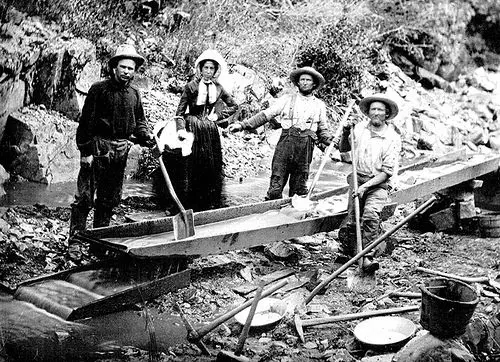Goldrush!
If there is anything that changed the course of the population of the western United States, it was the Gold Rush of 1848 to 1855. Before this time migration to the west had been slow and due to the hardships, only for those that could withstand the difficulties.
When gold was found in California, it opened up the floodgates and over 300,000 people showed up from all over the United States and the world in hopes of “striking it rich” with the discovery of their own gold.
The famous location of the discovery of gold was at Sutter’s Mill close to the California city of Coloma. A man named James Marshall was in the process of building the sawmill for the owner of the property, John Sutter.

While building the sawmill he started seeing shiny little gold flakes in the river. Once he told Mr. Sutter they made an attempt to try to keep the discovery a secret but it didn’t take long for the word to get out and hundreds of prospectors headed to California.
The gold rush changed the population of that area of California from 14,000 non-Native Americans to around 20,000 people between 1848 and 1849.
By the end of 1849 over 90,000 people had shown up to either hunt for gold or be a part of the supporting community. This last huge group of people were called the “Forty-niners,” and they were from places all over the world.
Prospectors used a few ways to try to find gold and many that arrived found so much gold that they earned ten times what they might have made in regular jobs. Panning for gold was the most profitable and individual prospectors would spend weeks in the panning process.
Panning involved scooping up a bunch of gravel, dirt, sand and water and then shaking the pan back and forth to separate the contents. Gold is heavier than the rest of the contents and would sink to the bottom of the pan.
The miners could then remove the gold and get rid of the rest. As time passed, other more efficient ways of getting gold were developed and this led to some of the miners working together to get larger quantities of gold.
Almost all of the miners arrived in California without any of the necessary supplies that they would need. Some of the store owners stocked up on the supplies to sell to the miners and in many cases they became richer than the miners.
The most common items that were sold included supplies required to survive such as bacon, sugar, coffee, beans, flour, bedding, a kettle, a tent, and lamps. The idea of “supply and demand” allowed the business owners to sell the supplies at higher prices.

Locations where gold was discovered quickly changed into mining camps. These camps would grow quickly and were called “boomtowns.” It didn’t take long for them to balloon into larger towns and cities and two of them that remain today are San Francisco and Columbia, California.
The explosive growth of many towns can be credited to the gold rush but once the gold veins ran out the locations also so the opposite happen as people left the areas in droves.
Once the miners left, so did the local businesses and the populations were reduced to the point that towns were empty. These are called “ghost towns” and there are still a few that remain as tourist attractions today such as Bodie, California.
What did you Learn?
What is the name of the location in California where gold was first discovered?
Sutter’s Mill
What did they call the massive group of miners that showed up in California in 1849?
Forty-niners
Other than gold mining, who else made a lot of money during the gold rush?
Local business owners selling supplies to the miners
What was the most popular way to find gold during the gold rush?
Panning
What were the cities called that were created as a result of the gold rush?
Boomtowns
What were some of the basic supplies that the gold miners bought?
Bacon, sugar, coffee, beans, flour, bedding, a kettle, a tent, and lamps



